 LAODICEA
LAODICEA
TURKEY Between Two Worlds
 LAODICEA
LAODICEA

The city is located in the Lycus River Valley together with Hierapolis and
Colossae. This valley is a natural route of travel from east to west.

The city was founded by the Seleucid king Antiochus II and named for his wife
Laodice about 260 B.C.
This triple-arched gateway was dedicated to Domitian (81-96). Apparently Laodicea received the gospel not from Paul but from his helper Epaphras during the time Paul was in Ephesus. Paul wrote the church here a letter during his first Roman imprisonment. This letter is not known historically and some have suggested that it is the letter now known as Ephesians.
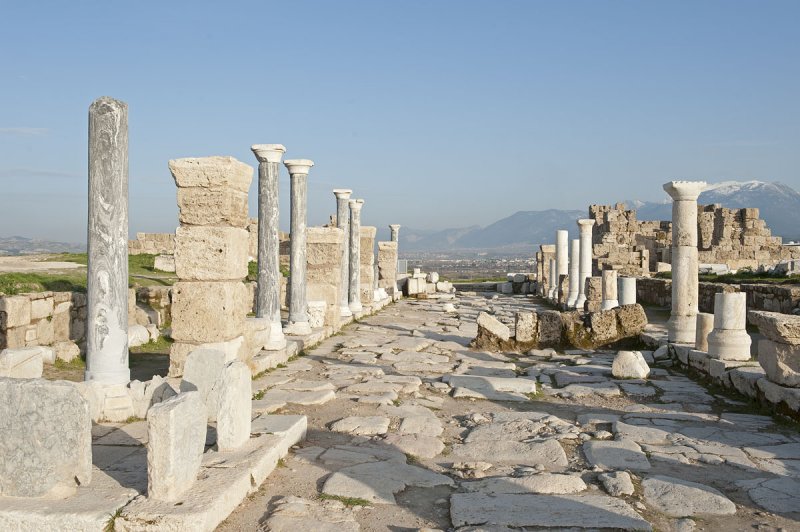
Syria street
The 900 meters long main street stretching from the city centre to the Syria Gate in the east is called the Syria Street. The 400 meter long stretch from the Caralla Fountain to the East Byzantin Gate has been unearthed and restored. The excavations made clear construction phases related with the 464 AD earthquake and on until the abandonment of the city. A sewage canal runs under the middle of the street which is flanked with colonnades rising on a single – or a two-step platform with shops behind. The street was first built in the Hellenistic Period and the rebuilt in the Doric order during the reign of Domitian (81-96 AD), and following earthquakes. The street stayed in use until the early 7th century when the city was abandoned. Reconstruction works recreates how it looked in the 6th century, using bases, capitals and columns found in situ. This Eraly Byzantine period street was built on a system of alternating two columns and one pier. The street is repaved with reused marble architectural elements and the statues served as lid-stones for the sewage canal. The porticos flanking the street had a lean-to rook and remains of opus sectile pavement and very little amount ofmosaic pavement have been uncovered. On the porticos, by the doorways to the shops are seats created by various reused architectural elements like architraves, bases of capitals some of which were incised with various game board designs. Next to the House A is an arched tetrapylon allowing access in four directions with a cross motif in low relief on its capital. Some columns and piers were left lying to give visitors a sense of the 7th century earthquake.

This triple-arched gateway was dedicated to Domitian (81-96). Apparently
Laodicea received the gospel not from Paul but from his helper Epaphras during
the time Paul was in Ephesus. Paul wrote the church here a letter during his
first Roman imprisonment. This letter is not known historically and some have
suggested that it is the letter now known as Ephesians.

House A. 3rd – 4th century AD, storage jar and brick floor indicate alterations which transformed the building to a workshop in the 5th-6th century AD; three phases of usage can be identified. It had sitting rooms, pools, many trade-related articles were found.

Temple A which was built with travertine blocks on a high podium and faced with marble. Built in the Antonine period (second century AD) it was heavily renovated during Diocletian (284-305). Excavations showed it was used as an archive in the fourth century AD.

View of the Central Agora. In front the Syria Street with Temple A

The Central Baths, 89,60 x 57,60 meters, are to the south of the Central Agora
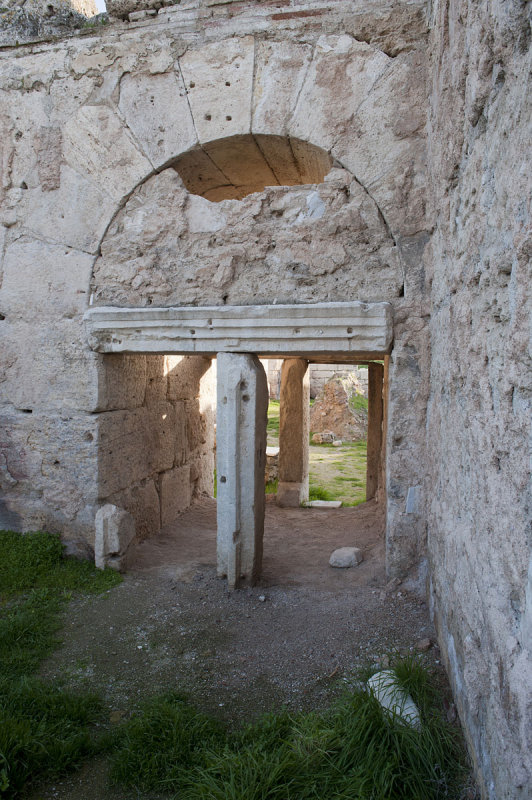
The Central Baths dated to the Imperial Period (second century AD)
"And unto the angel of the church of the Laodiceans write; These things saith the Amen, the faithful and true witness, the beginning of the creation of God; 15I know thy works, that thou art neither cold nor hot: I would thou wert cold or hot. 16So then because thou art lukewarm, and neither cold nor hot, I will spue thee out of my mouth" (Rev 3:14-16)

Following its collapse in the 494 earthquake it served other functions until the city was abandoned in the early 7th century AD. One of its entrances.

The Caracalla Nymphaeum was built in honor of, and dedicated to, Emperor Caracalla (r. 211-217 AD) on the occasion of his visit to Laodicea. It underwent four repair phases, the last in the early 5th century. It had two storeys in Corinthean order. It had an almost square rectangular (8,90 x 7,90 meters) pool with two apsidial pools on either side. The parapet balusters extant are decorated with scenes of Heracles, Abduction of Ganymede and Theseus slaying the Minotaurus. I did not see or inspect these.
A small-scale excavation of the site was carried out 1961-63 by a Canadian team led by Jean des Gagniers. The focus of their work was on the nymphaeum which was supplied water from the Baspinar Spring by an aqueduct that still survives. The nymphaeum was dated to the early 3rd century A.D.

Entrance part to the North Theatre. This theatre dates from the second century AD, it faces the Lycos Plain to the northeast. It is built into the hill side. Some rows slipped or disappeared due to quarrying, still many remain. It was thought to have housed up to 12.000 people. It was used until the 7th century, than used as a quarry.

The North Theatre
This theatre dates from the second century AD, it faces the Lycos Plain to the northeast. It is built into the hill side. Some rows slipped or disappeared due to quarrying, still many remain.
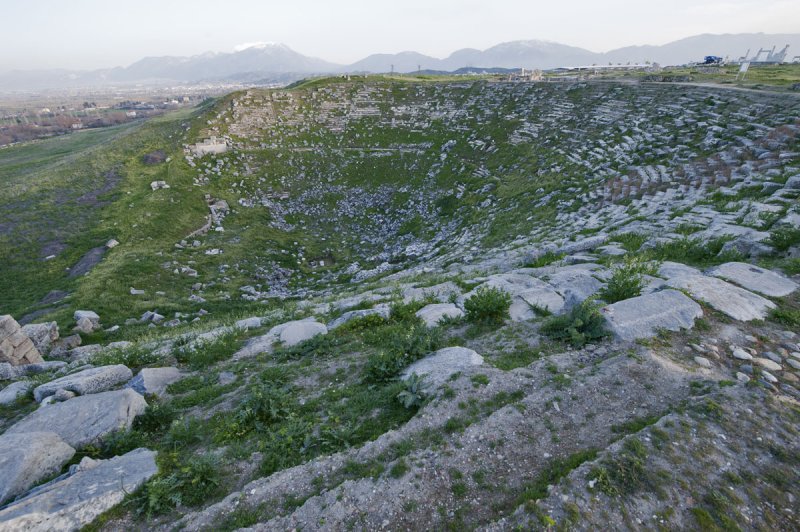
It was thought to have housed up to 12.000 people. It was
used until the 7th century, than used as a quarry.
Stadium
One of the few stadiums preserved from the ancient world, this one at Laodicea
was built by Nicostratus and dedicated to Vespasian in 79 A.D. according to an
inscription found here.
The stadium is circular at both ends and was the total complex was 900 feet
long. Used primarily for running races, the length of the track was fixed at 600
feet, also known as one stadium.
Hierapolis

Founded by a king of Pergamum in around 190 BC, Hierapolis was a cure center under the Roman Empire because of the magical springs of Pamukkale nearby.
When looking out over Hierapolis, you can see enough remnants of the town to imagine the street grids. As a plateu overlooking Pamukkale, Hierapolis is very beautifully situated. The view from the Theatre is quite grand. Not as much is left of the town as at Ephesus, but there's a better sense of the wide range of streets.

Tetrapylon, ceremonial gateway into
the city

The theater
Hierapolis is (Enc. Britt.) an “ancient Phrygian city in southwestern Turkey. … It was probably established by Eumenes II of Pergamum in 190 BC. It became a sacred city (hieron), its chief religious festival being the Letoia, named after the goddess Leto, a local variant of the Great Mother of the Gods, who was honoured with orgiastic rites. There was also a worship of Apollo Lairbenos. Hierapolis was rebuilt during the reign of the Roman emperor Tiberius in approximately AD 14–37 and survived until 1334, when it was abandoned after an earthquake. Extensive ruins, excavated since the 19th century, include baths, a gymnasium, an agora, and a Byzantine church.

The stage is more intact than many other theaters
The theatre is of an impressive size and occupies four blocks. The cavea is divided into two parts by the central diazoma and vertically by 8 staircases into 9 kerkides. Above was the gallery of the summa cavea. In the centre of the ima cavea (the lower seats) is a large marble exedra with seats having lion paw terminals and high backs for persons of high status. The stage building is divided into a logheion (the stage itself) and a scaena. The scaenae fons was divided into three superimposed orders, sitting upon a podium decorated with a figurative cycle dedicated to Apollo and Artemis. This building was erected in the third century AD during the reign of Septimus Severus, enveloping and cancelling an earlier theatre, perhaps of Flavian date. The theatre was used into late Roman times; an inscription dating to 352 AD cites the restoration of the scaenae fons.

The graveyard or Necropolis (City Of The Dead) just outside of Hierapolis is the
largest ancient graveyard in Anatolia with more than 1200 tombs (most are above
ground burials in sarcophagus). Today, nothing is left of the dead except the
stones as successive earthquakes and tomb robbers have taken their toll. There
are tombs stretching over a considerable period from the Hellenistic, Early
Christian to Roman periods.

Temple of Aphrodite

The Martyrion of St. Philip
The Martyrion was the
most important Christian cult building at Hierapolis. The structure is composed
of a central octagonal room. Eight rectangular rooms open onto it, each with
three arches supported by columns on marble octagonal plinths. The number eight,
which lies at the base of the entire complex architectural geometry, has a
strong symbolic significance. The arches bear Christian symbols with circles
(cross with a star, Chrismon [Wikipedia: A chrismon is one of number of
Christian symbols intended to represent aspects of the Person, life or ministry
of Jesus Christ and the life, ministry or history of the Christian Church
through a single image, emblem or monogram. The term "chrismon" comes from the
Latin phrase "Christi Monogramma",]). The central room, once capped by a wooden
dome, contains a synthronon (the stepped semicircular benches for the clergy and
the bishop during the liturgy). The complex church plan was included in a
square, which is surrounded by 32 rooms aligned along the sides. The building
must have held the earthly remains of the Apostle Philip. The martyrion was
built in the early 5th century AD, perhaps by an architect from the court of
Constantinople.

Tumulus 51 (1st century BC)
Tumulus consisting of low cylindrical drum made of travertine slabs supporting
an earth cone. Two flights of steps lead to the antechamber of the subterranean
funerary chamber, covered by a barrel vault with sepulchral beds along the
walls. The building was built in the late Hellenistic age; an inscription of the
2nd century AD refers to the last occupant, Lucius Salvius Paolinus.

General view of Hierapolis

Nero crowned as Emperor by his mother Agripina
Colossae




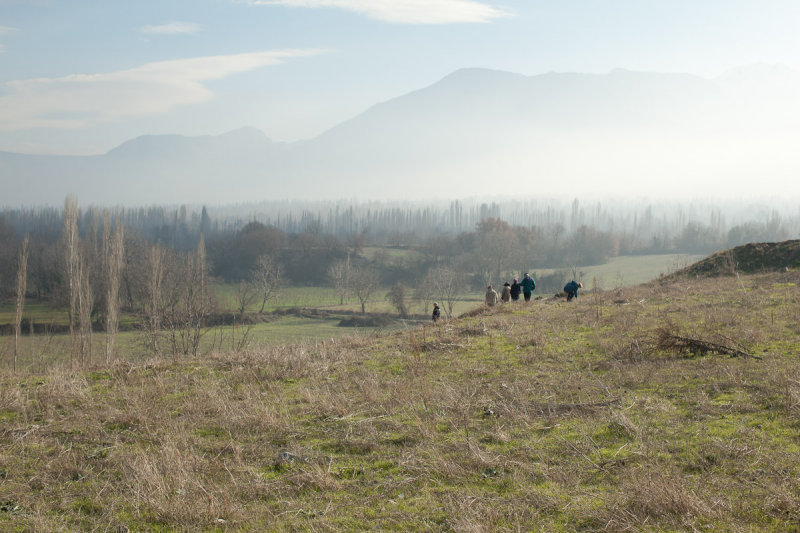

Pamukkale

The travetine pools of Pamukkale are really quite spectacular

Hot springs spurt out calcium rich water that pour over the hillside and limestone deposit forms as the water cools leaving a white kind of winter wonderland of calcium
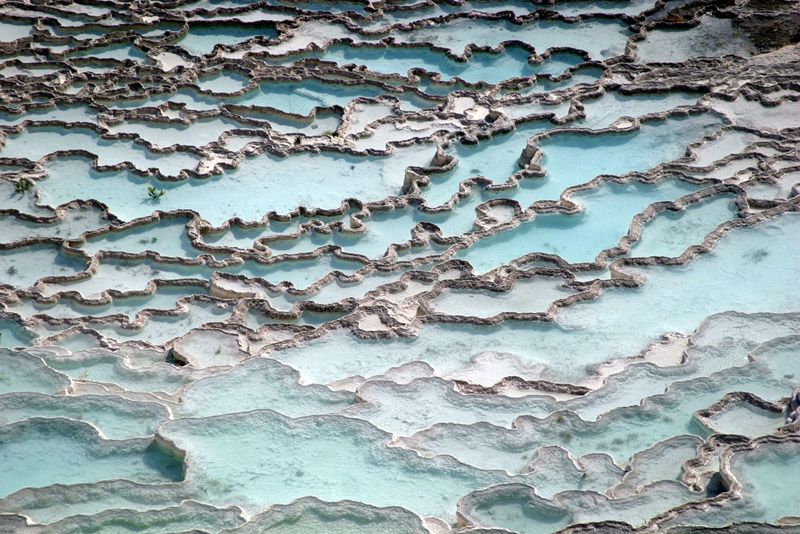
Pamukkale means "Cotton Castle" in Turkish

People have been coming to the nearby
ancient town of Hierapolis to enjoy the curative powers of the hot spring waters
for thousands & thousands of years.

The ancient spa metropolis of Hierapolis was a booming city with a popular
thermal spa as early as the Hellenistic times (200-300BC)during the times of
Alexander The Great. Hierapolis was founded by Eumenes II, King Of Pergamum and
was ceded to Rome in 133BC. The city was destroyed by an earthquake in 60AD. The
gateway into the city is through the Arch Of Domitian - dedicated to the Roman
Emperor.
GOD IS THE LORD WHO DOES MIRACLES
Powered by:
DENVINCENT.Com.Inc.
Sumber: Dick Osseman